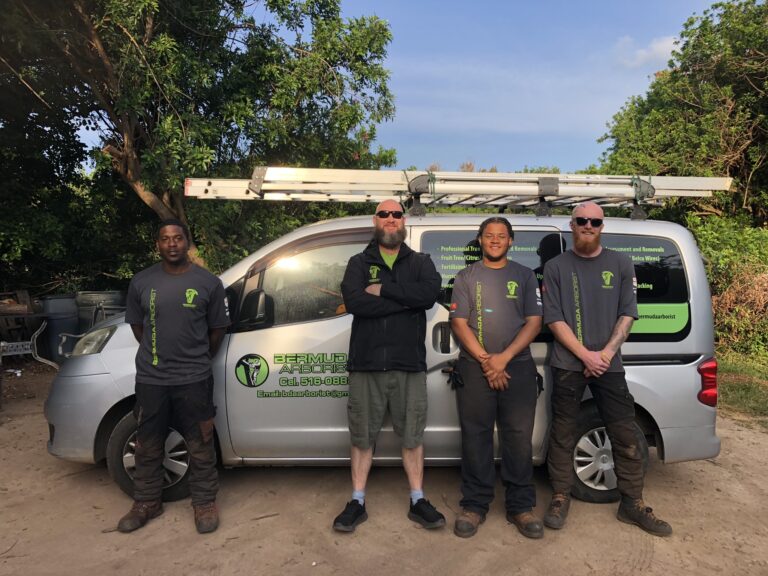In Bermuda, majestic trees are not just a thing of beauty, they provide cooling shade in our hot summer weather and serve as essential shelter for wildlife. But thanks in part to our sub-tropical climate, many species of trees experience an extended growing season and can reach soaring heights in a relatively short time, making proper tree maintenance an essential part of home ownership in Bermuda.
But even though the Ministry of Public Works regularly issues bulletins reminding us that, “owners of property adjacent to a road are responsible for trimming back overhanging trees and hedges on their properties to stop vegetation from projecting into the roadways or sidewalks,” pruning foliage is a laborious (and sometimes costly) task that it is tempting to defer as long as possible.
As we are all too aware, however, there’s nothing like a good old-fashioned hurricane to show us where we have been remiss.
But as much as felling a tree may seem like a “one and done” situation, there is a lot that can go wrong if you lack the knowledge or proper tools for the job. I caught up with David McCann, Bermuda’s preeminent tree surgeon and owner of Bermuda Arborist, at his yard in Radnor Estate, to get some savvy advice for would-be lumberjacks.
What is a tree surgeon?
As a custodian of Bermuda’s arboreal heritage, a tree surgeon is charged with nurturing, preserving, and maintaining the island’s living treasures.
“Beyond the basic tasks of pruning and planting, my team and I focus on soil science, fertilization, diagnosing diseases, pest control, and tree removal,” says Mr. McCann. “There’s a lot you need to know to keep trees healthy because each type of tree has its own specific wants and needs when it comes to fertilization and pest control”.
ASSESSING THE HEALTH OF A TREE
Tree cutting requires specific knowledge and skills to ensure it is done safely and effectively. Without proper training, you may not understand how to assess the tree’s condition, determine the direction of fall, or use tools such as chainsaws safely.
“A lot of people don’t realize that most health issues with trees originate in the roots because that is how a tree feeds itself,” Mr. McCann explained.
“The first thing that I always do is assess the health of a tree from a distance to get a sense of the overall state of the canopy and foliage – checking for airflow or included bark (branches that are fused together),” he said. “Then I put my hands on the tree to perform a manual inspection to search for soft softs, cavities, or signs of decay.”
COMMON DISEASES AND PESTS IN BERMUDA
Aphids: Small insects that attack the new growth on roses and citrus trees resulting in distorted leaves and a failure to develop blossoms and fruit.
Ganoderma: A fungus that kills palm trees. It remains in the soil even after the tree has been removed, making it necessary to replace the soil before replanting.
Scale Insects: All species of trees in Bermuda are susceptible to scale insects that feed on trees causing them to excrete a sweet sticky “goo” which ants love. The ants then track this substance all over the tree which in turn leads to the development of black sooty mold causing the overall health of the tree to decline.
MISGUIDED MAINTENANCE ISSUES
The roots of a tree are not meant to be completely buried – as a rule, the trunk is supposed to flair upward from partially exposed roots. “If you mound soil up around the base of the trunk to cover the roots, the moisture in the soil will cause the bark to start to rot,” he cautioned.
“Pruning is also quite a scientific activity because you should only thin out areas that are too congested to give the tree better access to air and light, and you should only cut a branch in a place where the tree can naturally heal itself,” he explained.
“Believe it or not, if you cut the wrong branch, this can lead to the slow decline and death of a tree (and this is particularly true of Bermuda cedar trees). It can also leave a tree susceptible to disease, and in the worst-case scenario it can make the tree more likely to blow over in a storm.”
SAFETY CONSIDERATIONS
While the allure of wielding a chainsaw may tempt some to attempt tree removal independently, the complexities and risks involved underscore the importance of consulting an expert.
Improper tree-cutting techniques can result in a tree falling in an unintended direction, potentially damaging nearby structures, vehicles, or other property.
“Never forget that mistakes with a chainsaw are permanent and most YouTube videos are incorrect!” says Mr. McCann. “It goes without saying that it’s important to use the proper harness, hard hat, gloves, and eye protection at all times, but it’s equally essential to ensure that you are using the right tool for the situation you are facing.”
“A lot of people might be surprised to know that I have 30 chainsaws – not just one,” he said.
“I can’t tell you how often we get calls from people who have either injured themselves, seriously damaged a tree, or are just too overwhelmed to finish the job,” he said. “Safety is a huge part of tree pruning – both for the welfare of the tree and for the people involved.”
On our hurricane-prone island, neglecting the care of our natural resources can pose significant safety risks. While it’s perfectly fine to trim your own hedges, proper tree care requires a blend of science, skill, and safety best managed by trained professionals.
By following the advice of arborists like Mr. McCann, however, homeowners can ensure their trees continue to thrive, preserving the natural beauty and ecological balance of our island for future generations. For advice or a free assessment, contact Bermuda Arborist on Facebook or call 516-0880.

